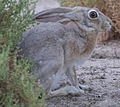This article has multiple issues. Please help improve it or discuss these issues on the talk page . (Learn how and when to remove these messages)
|
| Cape hare | |
|---|---|
 | |
| Scientific classification | |
| Kingdom: | Animalia |
| Phylum: | Chordata |
| Class: | Mammalia |
| Order: | Lagomorpha |
| Family: | Leporidae |
| Genus: | Lepus |
| Species: | L. capensis |
| Binomial name | |
| Lepus capensis | |
 | |
| Geographic range | |
The Cape hare (Lepus capensis), also called the brown hare and the desert hare, is a hare native to Africa and Arabia extending into India. [1]



